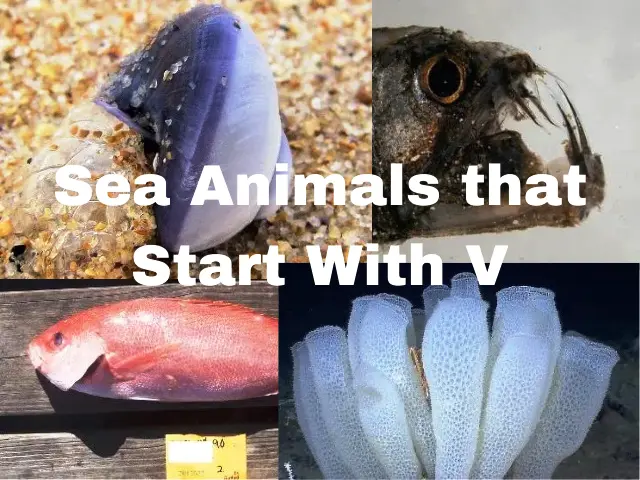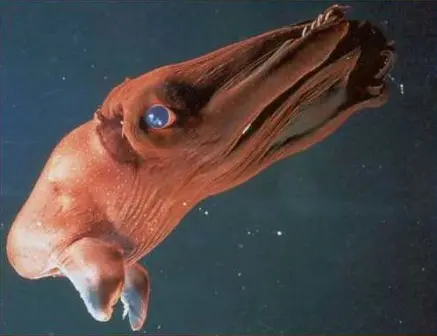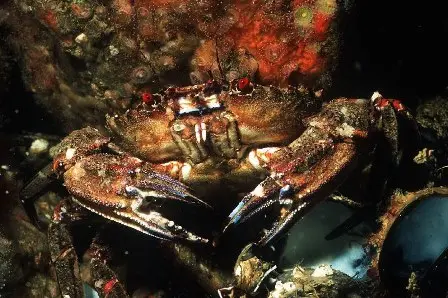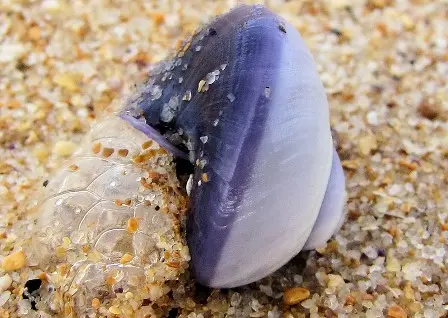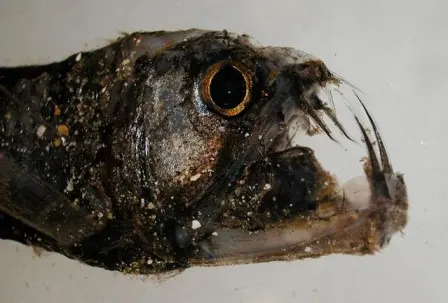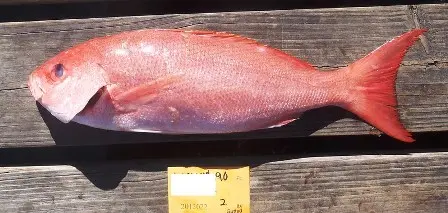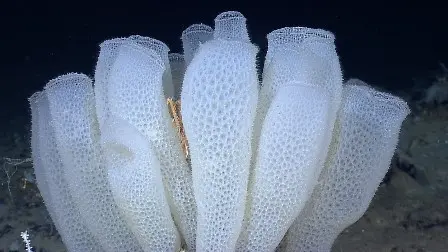Sea animals are animals that live inside the sea. It includes sharks, snails, fish, whales, and dolphins.
Unfortunately, we are not aware of all the sea animals. For example, do you know that cucumber grows inside the sea? It is not a vegetable but an animal that grows in the sea.
It is believed there are 2 million types of sea animals which we humans have not yet discovered.
The article lists sea animals that start with V. So you can keep reading this article to learn about some of the fascinating sea creatures that begin with the letter V.
MORE POSTS: 10 Zoo Animals that Start with X
What Are the Sea Animals That Start with V?
We are listing below some sea creatures that begin with the letter V.
1. Vampire Squid
The scientific name of the vampire squid is Vampyroteuthis infernalis. But remember, the animal is neither a vampire nor a squid. It belongs to the phylum Mollusca. The animal is found in temperate and tropical deep seas.
It uses its bioluminescent organs and unique oxygen metabolism to exist in the deep sea, with a deficient oxygen concentration.
One of the most essential characteristics of vampire squid is its clear eyes. The eyes are pretty large in comparison to its body. It has the largest eye in contrast to other living animals. The eyes may look blue when ROV lights fall on them.
It is because the eyes of the animal reflect the surrounding water when lights fall on them and appear blue.
The Vampire squid has eight long arms, and at the end of each arm, you will find a light-producing organ that produces blue light.
It has two tentacles that can extend up to 8 times the size of the body. The tentacles have sensory nerves and small hairs that help to sense the surroundings and detect the food. You will find two white spots on the head called photoreceptors.
The maximum total length of the vampire squid is 30cm, and females are usually larger than males.
Vampire squid doesn’t change color like squirt or octopus. The squirt or octopus has specialized muscles that control chromatophores and allow them to change body color. But Vampire squid has no specialized muscles, so they cannot change color.
2. Velvet Crabs
Velvet crabs are medium-sized crabs that are found in the deep sea. They are even known as devil fighters or lady crabs.
The appearance of the crab gives them a velvet appearance. You will find small hairs on the crab’s entire body, which are pretty soft to the touch, just like velvet. Hence, its name is velvet crab.
The rear legs are pretty flat and look precisely like paddles. The velvet crab can easily swim in deep sea or tidal currents by the rear legs.
Velvet crabs even have red eyes, distinguishing them from other crabs. They live for almost five years. The females carry fertilized eggs underside to protect from predators.
A female velvet crab can produce almost one million offspring throughout her life. The offspring will reproduce after one cycle; thus, the cycle continues continuously.
These crabs have more than average speed inside the water. Hence, they are pretty expert in catching their prey during swimming. Velvet crabs feed on prawns, seafood, seasnail, fish, and many more.
You will find velvet crabs mostly in Europe, Ireland, or the UK coastlines. These animals are mainly found 100 meters below the sea.
The velvet crabs are consumed in various places like Ireland because of their dietary value. It is difficult to cook this crab compared to the brown crab. But the meat is quite delicious.
3. Violet Sea Snail
The Violet sea snail is the next sea animal, which is quite fascinating and is mainly found in tropical and subtropical water.
The violet sea snail is small, and the shell grows almost coin-sized. The shell of this snail is quite attractive. It is conical in shape and is of violet or purple color.
The soft and fleshy bodies of these creatures are also purple. Hence, they are purple from both inside and outside. The size of this snail is usually 4 cm in height and 3 cm broader.
A fil known as mantle covers the entire body of the violet sea snail.
The mantle’s primary purpose is to protect from predators and keep the body moist every time. The snail even has tentacles with the help of which it senses and finds the presence of its food.
So, what does this sea snail feed? The violet sea snail uses its radula to scape the algae or other plant matter grown on rocks.
You can find these snails in the Pacific Ocean, Atlantic Ocean, and Indian Ocean. If you have ever been to these areas, you will find the Viloet sea snail.
The reproduction of this sea creature is quite interesting. They start their life cycle as males and gradually become females as they age.
The male snail doesn’t have a penis. So, mating doesn’t take place directly in these sea creatures.
So, they deposit sperm in cases that float to females, and then fertilization occurs. Free swimming larvae are produced on the hatching of eggs and released directly inside the sea.
The tiny snail can produce mucus and bubbles and float on water. They can even feed independently.
Violet Sea snail has an exciting method of living inside the ocean. They produce mucus from the food gland, which mixes with air bubbles when sea creatures travel on water.
The mixture gets hard and is known as a raft. The snail attaches to the raft and floats on the sea. But the creature goes deep inside the sea once the raft breaks. The snail may die soon as they cannot produce another raft in such an environment.
The upper side of the sea snail is light purple, and the inside is a deep purple. These creatures can attach to the raft upside-down and protect themselves from predators or strong ocean currents.
These snails are endangered species now. They are usually collected for their beautiful snails. Humans use these snails for decoration purposes.
4. Viper Fish
Viperfish is a deep sea fish that grows to 11-12 inches. It is one of the most popular fish species, and its scientific name is chauliodus sloani.
You can easily recognize this fish by its appearance. The fish has a large mouth and sharp, pointed teeth. The teeth are so large that they don’t fit inside the mouth. They curve back and are very close to the eyes.
The viperfish uses its sharp teeth to catch its prey. The dorsal spine of this creature has a light-producing organ known as a photophore. It uses the photophore to attract its prey. It flashes the light on and off like a fishing lure and attracts smaller fish.
Photophores on the sides of the viperfish help camouflage the fish and protect it from predators.
They are often seen motionless in the water and wave the lure over their head to trap their prey like small fish and crustaceans.
Another exciting thing about this creature is that they have a hinged skull, which they can rotate to catch large prey.
The fish’s stomach is also quite large, allowing them to reserve food when it eats plenty.
Viper is a deep sea creature and moves continuously in the sea during the daytime.
During the day, you can find them 5,000 feet below the sea at night. However, at night time, they are 2,000 feet below the sea. Another exciting thing about fish is that they have a slow metabolic rate. It means they can live for many days without eating any food.
These creatures are found in deep seas. Hence, there has not been much research till now regarding the reproductive system of this fish. However, it is believed that female viperfish release eggs inside the seawater.
The egg hatches and produce young larva 6 millimeters during hatching and search for food themselves. The life span of the viperfish is usually 15 to 30 years.
5. Vermilion Snapper
Vermilion snappers have streamlined bodies, usually pale to white at the bottom and reddish or vermillion at the top.
The fish’s dorsal fin is a rose color with a yellow edge, and the caudal fin is a red color with a black edge.
These fish grow very slowly and can grow up to 2 feet. The weight of the Vermillion snapper is almost 7 pounds, and it has lived for almost 15 years. These fish can start reproducing when they are one to two years old. They spawn various times yearly, but mainly from June to August.
You will mainly find these types of fish in the Atlantic Ocean, i.e., 60 to 400 feet deep inside the water. They feed on shrimps, crabs, worms, squids, and plankton.
6. Venus Flower Basket
The Venus flower basket is a unique creature found in deep water inside the Pacific Ocean, Indian Ocean, and Atlantic Ocean. These creatures are a type of glass sponge and are pretty famous for their size and structure.
Various types of Venus flower baskets are available, each with unique characteristics. Both male and female live inside the same structure and plays a primary role in the ecosystem inside the deep sea.
These creatures attach to the solid bodies or ocean floor and can easily withstand harsh conditions, tidal currents in the sea, pressure, or temperature changes. These creatures are pretty famous for their intricate structure. There is no fluid-filled cavity between the body wall and organs inside the body.
The internal space consists of interconnected gastrointestinal cavities, which perform critical processes like digestion, transporting nutrients, and removing waste.
Conclusion
Numerous animals reside inside the sea. But we have listed six sea animals whose name begins with the letter V. We hope the information provided in this article is helpful.
Thank you for reading this article, and please share it with your friends or anyone interested to know about fascinating sea animals.
MORE POSTS: 7 Unique Farm Animals that Start with T
Ankurman Handique
Latest posts by Ankurman Handique (see all)
- How to Reach Kaziranga National Park: A Complete Guide - June 29, 2024
- What animals are found in Puerto Rico? - February 23, 2024
- What does coyote poop look like? - February 20, 2024

